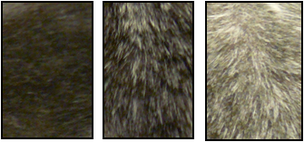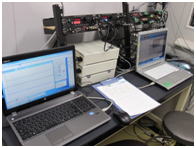Research
<Outline>
Our lab is focusing on the prevention of environmental factor-mediated diseases through elucidation of the mechanisms for the diseases using methods
of fieldwork study including epidemiology and cutting-edge study of molecular biology as shown below.
< Molecular Biology Study >
1. Molecular Oncology for melanoma
2. Skin Biology using original model mice
3. Neurophysiology for deafness and balance
< Fieldwork Study >
4. Environmental Health Science for water polluted by toxic elements
5. Epidemiology to investigate the effects of elements, noise and UV on human health
< Recruitment of graduate students from Asian and African countries>
We are recruiting graduate students who are interested in interdisciplinary research consisting of cutting-edge
molecular biology study and fieldwork study including epidemiology. Candidates who have passed the selection of scholarship from Monbu-Kagakusho (MEXT) in Japan or their own country are
especially welcome. Please do not hesitate to contact us because we are confident that we can provide you with a fruitful academic life in Japan.
Since the 21st century is the era of the environment, our research is focused on diseases caused by various environmental factors.
Our research is also focused on the development of preventive therapy for environmental factor-mediated diseases thorough combined molecular biology study and fieldwork study.
< Outline of Molecular Biology Study >
1. Molecular Oncology for melanoma
Background: It has been reported that the incidence of skin melanoma is increasing at a greater rate than that of any other cancer due to the ozone
depletion-mediated increase in UV light, indicating that melanoma is a typical disease induced by destruction of the global environment.
Our project: We have established a model mouse line for multi-step melanomagenesis via tumor-free, benign, premalignant, and malignant
stages (Fig. 1). The mouse model (RET-mice) is being used worldwide as a representative animal model. If young researchers and graduate students wish to
produce reports of high quality and to conduct research of cutting-edge molecular biology, conducting melanoma-related researches in our lab might be one way.
Fig. 1: RET-mice that spontaneously develop skin melanoma at high rates.

Histopathological appearances of hyperpigmented skin, benign melanocytic tumor and melanoma the spontaneously developed in a stepwise manner in RET-mice.
Related publications
01. J Clin Invest 2009
02. Cancer Res 2010
03. J Exp Med 2010
04. J Clin Invest 2010
05. PLoS Biol 2011
06. Proc Natl Acad Sci USA 2011
07. Cancer Res 2011a;2011b
08. Cancer Res 2012
09. Proc Natl Acad Sci USA 2013
10. Nature Immunology 2014
11. Oncotarget 2015a;2015b;2015c
12. OncoImmunology 2015
13. Oncotarget 2016
14. OncoImmunology 2016
15. Oncoimmunology 2017
16. OncoImmunology 2018
< Outline of Molecular Biology Study >
2. Skin Biology using original model mice
Background: UV light and chemicals are potential risks for pigmented disorders in the skin. Model mice with cutaneous pigmented disorders could be strong tools to
evaluate the health risks of UV light and chemicals.
Our project: We have established various model mouse lines with abnormalities of skin pigmentation including liver spots (Fig. 2), vitiligo (Cancer Res 2004) and
hair graying (Fig. 3). We are developing molecular target therapies by analyzing the mechanisms in the model mice. Researchers and graduate students who are interested in the development of
cosmetics using our original model mice are very welcome in our lab.
Fig. 2: Liver spot suspected skin disease


Fig. 3: A model mouse for hair graying

Related publications
01. Mol Biol Cell 2000
02. Oncogene 2001
03. Cancer Res 2004
04. J Invest Dermatol 2006
05. J Invest Dermatol 2007
06. Arch Toxicol 2014a
07. Exp Dermatol 2016
08. Arch Toxicol 2016a;2016b
09. Chemosphere 2018
10. Chemosphere 2019
< Outline of Molecular Biology Study >
3. Neurophysiology for deafness and balance
Background: Impairments of hearing and balance are major problems in the field of occupational and environmental health. However, the mechanisms have not been fully
clarified.
Our project: Our recent research using original genetically-modified mice focuses on novel molecules that regulate hearing and balance (Fig. 4). Moreover, we are
examining target molecules for noise-induced deafness. Fortunately, we found candidate compounds that are useful for preventing noise-induced hearing loss, age-related hearing loss and impairment
of balance in our animal studies. Thus, researchers and graduate students who are interested in neuroscience research on hearing and balance are very welcome in our lab.
Fig. 4: Physiological examinations for mice


Related publications
01. Proc Natl Acad Sci USA 2010
02. J Biol Chem 2011
03. Neurobiol Aging 2012
04. PLoS ONE 2012
05. Neurotoxicol 2012
06. Arch Toxicol 2014b
07. Sciense Rep 2017
08. Front Behav Neurosci 2017
09. Toxicol Res 2017
10. Hearing Res 2018
11. Toxicol Sci 2018
12. Arch Toxixol 2019
< Outline of Fieldwork Study >
4. Environmental Health Science for toxic elements
Background: Toxic elements including arsenic in drinking water are a health risk in developing countries in Asia and Africa (Fig. 5). However, there are very
limited cost-effective remediation systems for toxic elements in drinking water. Comprehensive study using knowledge and techniques in various fields including medicine, engineering and
environmentology is required to solve this serious worldwide problem.
Our project: Our research is focused on (1) identification of the elements in well drinking water by using an inductively coupled plasma-mass spectrophotometer, (2)
evaluation of the health risks of elements in well drinking water, (3) development of a cost-effective and convenient remediation system for well drinking
water, (4) practical realization of the remediation system in developing countries and (5) promotion of widespread use of the remediation system. Our ultimate goal is to contribute to health
promotion in developing countries through providing safe drinking water. Our Environmental Health Science research to remediate toxic elements in well drinking water has started in various
countries in Asia and Africa. Results of our research have been reported in various international papers as shown below. Since we are eager to further promote our Environmental Health Science
Research to provide safe water for people in developing countries in Asia and Africa, we are recruiting Master and PhD students from Asian and African countries.
Fig. 5: Patients with arsenicosis (Photographs provided by Dr. Shekhar in University of Dhaka, Bangladesh)

Related publications
01. Toxcol In Vitro 2011
02. Neurotoxicol 2012
03. Arch Toxicol 2012
04. Arch Toxicol 2013
05. PLoS ONE 2013
06. Arch Toxicol 2014
07. Environ Toxicol 2015
08. Environ Pollut 2015
09. J Invest Dermatol 2015
10. J Water Health 2016
11. Chemosphere 2016
12. Arch Toxicol 2017
13. Chemosphere 2018
14. Chemosphere 2019
< Outline of Fieldwork Study >
5. Epidemiology to investigate the effects of elements, noise and UV on human health
Background: Epidemiological research could be a strong tool to clarify the correlations between environmental factors and health in humans. Our recent research is
focused on toxic elements, ultraviolet light and noise as environmental factors. Our recent research is also focused on skin disorders and hearing disorders as human diseases.
Our project: Various projects for occupational health as well as environmental health are being conducted in Asian countries including Japan. Our recent papers for
epidemiological research have been rapidly increasing. Researchers and graduate students who are interested in fieldwork including epidemiological research in their own countries are very welcome
in our lab.
Related publications
01. Toxicol Ind Health 2011
02. Cancer Epidemiol Biomaker Prevent 2011
03. Int J Environ Res Public Health 2013
04. PLoS ONE 2015
05. J Expo Sci Environ Epidemiol 2016
06. Toxicol Sci 2016
07. Chemosphere 2018
08. J Expo Sci Environ Epidemiol 2018
09. Biomarkers 2018
10. Sci Rep 2018
11. Sci Rep 2019
